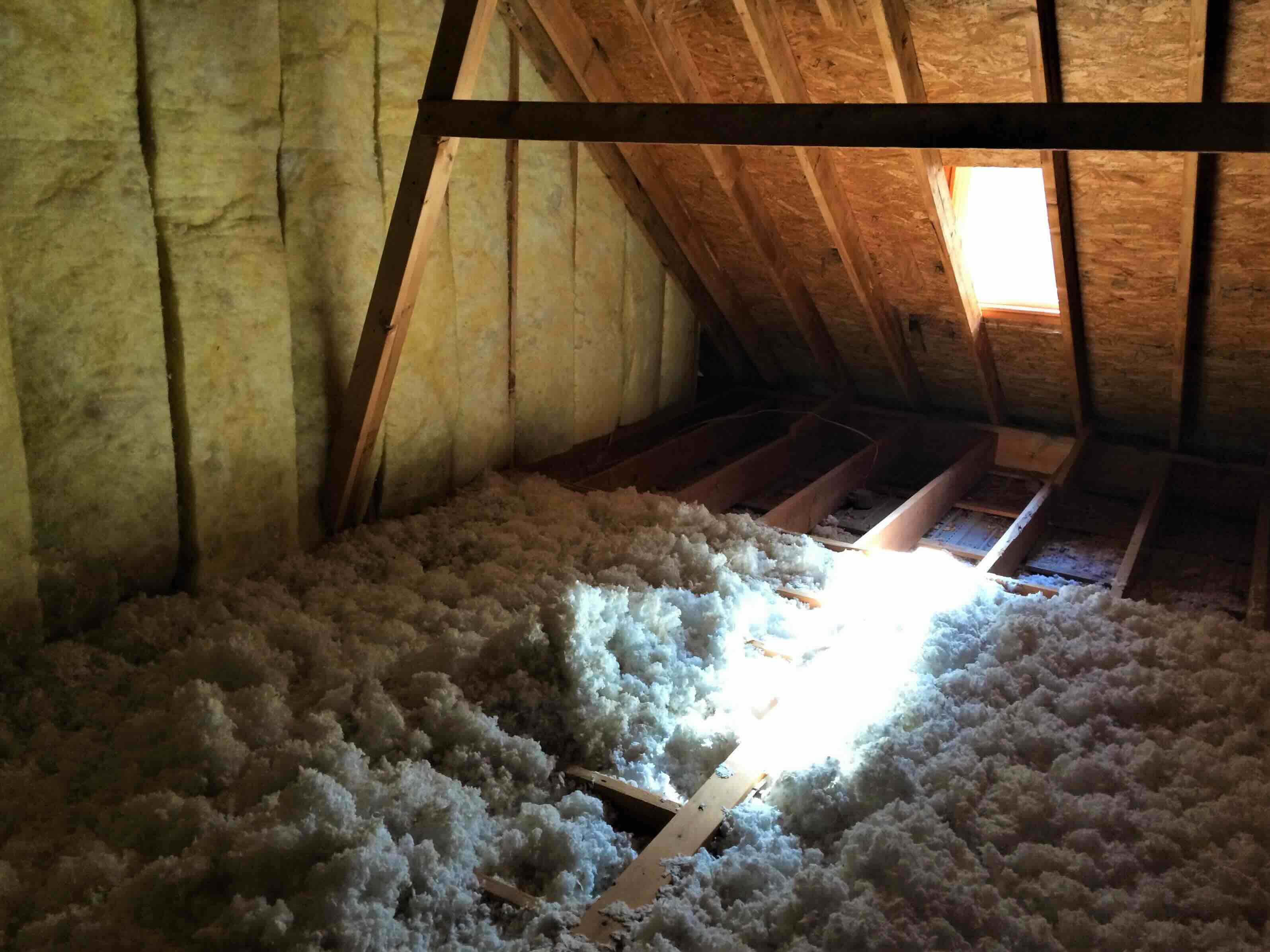Home>Articles>How Much Does It Cost To Replace Ductwork In Attic


Articles
How Much Does It Cost To Replace Ductwork In Attic
Modified: October 18, 2024
Need to replace the ductwork in your attic? Read our informative articles to find out how much it will cost to tackle this home improvement project.
(Many of the links in this article redirect to a specific reviewed product. Your purchase of these products through affiliate links helps to generate commission for Storables.com, at no extra cost. Learn more)
Introduction
Replacing ductwork in the attic is a common home improvement project that homeowners may need to undertake. Ductwork plays a crucial role in distributing air throughout your home, and when it becomes damaged or inefficient, it can have a significant impact on your comfort and energy bills. In this article, we will explore the ins and outs of ductwork replacement in the attic, including the signs that indicate the need for replacement, factors influencing the cost, and whether it is a job you can tackle yourself or if hiring a professional is the best option. So, if you’re curious about how much it would cost to replace your ductwork in the attic, and what factors you need to consider, keep reading.
Key Takeaways:
- Signs of ductwork issues include uneven heating, poor air quality, high energy bills, noise, and visible damage. Promptly addressing these signs can prevent further discomfort and damage to your home’s HVAC system.
- When considering ductwork replacement, factors such as the size of your home, material costs, labor expenses, and geographic location play a significant role in estimating the overall cost. Thorough research and obtaining multiple quotes from reputable contractors are essential for planning your budget.
Read more: How Much Does HVAC Ductwork Cost
Understanding Ductwork in the Attic
Ductwork in the attic is a system of pipes or channels that distribute heated or cooled air throughout your home. It is typically made of metal, such as galvanized steel or aluminum, and is installed in the attic space to avoid taking up valuable living space. The layout and design of ductwork can vary, but it generally consists of supply ducts that deliver conditioned air to each room and return ducts that carry the air back to the HVAC system for treatment.
The attic is a common location for ductwork because it is often the most accessible and convenient space to install the system. However, it is also subject to unique challenges. The attic environment can be extremely hot in summer and cold in winter, which can impact the performance of the ductwork. Additionally, the insulation in the attic must be properly installed and maintained to prevent heat transfer and energy loss.
Properly functioning ductwork is essential for maintaining a comfortable and energy-efficient home. Damaged or poorly designed ductwork can result in uneven heating or cooling, decreased indoor air quality, and increased energy bills. Therefore, it’s important to be aware of the signs that indicate the need for ductwork replacement in the attic.
Signs of Ductwork Issues
Identifying signs of ductwork issues is crucial in determining whether it’s time to replace the ductwork in your attic. Here are some common signs that indicate you may be dealing with ductwork problems:
- Uneven Heating or Cooling: If some rooms in your home are significantly warmer or cooler than others, it could be a sign of ductwork issues. Leaks or blockages in the ducts can disrupt the airflow, causing uneven heating or cooling throughout the house.
- Poor Air Quality: If you notice an increase in dust, allergens, or unpleasant odors in your home, it could be due to leaky ductwork. Holes or gaps in the ducts can allow outside contaminants to enter the system, compromising the indoor air quality.
- Inefficiency and High Energy Bills: Leaky ducts can result in air leakage, causing your HVAC system to work harder to maintain the desired temperature. This inefficiency can lead to higher energy bills, as your system has to compensate for the lost air.
- Noise: If you hear unusual noises, such as rattling or whistling sounds, coming from your ductwork, it may indicate loose connections, leaks, or obstructions.
- Visible Damage or Deterioration: Inspect your ductwork for any visible signs of damage, such as holes, tears, or loose joints. Over time, ductwork can deteriorate due to age, pests, or improper installation.
If you notice any of these signs, it’s important to address the ductwork issues promptly to avoid further damage and discomfort. Assessing the condition of your ductwork and determining whether it needs replacement requires a thorough inspection and consultation with a professional.
Factors Affecting the Cost of Ductwork Replacement
Several factors come into play when determining the cost of replacing ductwork in the attic. Understanding these factors can help you plan your budget and make informed decisions. Here are some key factors that can influence the cost:
- Size and Complexity of the Ductwork: The size of your home and the complexity of the ductwork system will impact the overall cost. Larger homes will require more ductwork, which will increase the material and labor costs. Additionally, if the layout or design of the ductwork is complex, installation and replacement may require more time and effort.
- Type of Ductwork Material: The material used for the ductwork will affect the cost. Common materials include galvanized steel, aluminum, and flexible ducts. Galvanized steel tends to be more expensive but offers durability. Aluminum is a cost-effective alternative, while flexible ducts are easier to install but may not be as durable in the long run.
- Accessibility and Location: The accessibility of your attic and the location of the ductwork can impact the cost. If the attic is difficult to access or if the ductwork is located in hard-to-reach areas, such as tight corners or crawl spaces, it may require additional labor and time, resulting in higher costs.
- Insulation Requirements: Insulating the new ductwork is essential to prevent energy loss and maximize efficiency. The type and amount of insulation needed will affect the overall cost. Proper insulation can also reduce noise transmission and ensure consistent airflow throughout your home.
- Additional Repairs or Modifications: If the existing ductwork has significant damage or if modifications are required to improve the system’s performance, the cost may increase. Common repairs or modifications include sealing leaks, replacing damaged sections, or adding dampers or registers.
- Contractor’s Experience and Location: The experience and location of the contractor can play a role in the cost. Contractors with more experience and expertise may charge higher rates. The location of your home can also impact the labor and material costs, as the prices can vary in different regions.
It’s important to consider these factors and obtain multiple quotes from reputable contractors to ensure you have a clear understanding of the costs associated with ductwork replacement in your attic.
Estimating the Cost of Ductwork Replacement
Estimating the cost of ductwork replacement in the attic can be challenging as it depends on various factors. However, having a rough idea can help you plan your budget accordingly. Here are some general guidelines to help you estimate the cost:
- Size of the Home: The size of your home is a significant factor in determining the cost. On average, homeowners can expect to pay anywhere from $1,500 to $5,000 for ductwork replacement in a standard-sized home. Larger homes will likely incur higher costs due to the increased amount of material and labor required.
- Material Costs: The type of material used for ductwork can also influence the cost. Galvanized steel is a popular choice but tends to be more expensive than aluminum or flexible ducts. The cost of materials, including insulation, can range from $5 to $20 per linear foot, depending on the material and quality chosen.
- Labor Costs: Labor constitutes a significant portion of the overall cost. On average, expect to pay around $50 to $70 per hour for labor. The total labor cost will depend on the complexity of the ductwork system, the accessibility of the attic, and the duration of the project.
- Additional Costs: In addition to the material and labor costs, there may be additional expenses to consider. These can include permits, equipment rental, disposal of old ductwork, and any necessary repairs or modifications.
- Geographic Location: The location of your home can impact the cost. Labor rates and material prices can vary from one region to another. It’s worth researching local market prices and obtaining multiple quotes from contractors in your area to get a better understanding of the cost.
It’s important to note that these estimates are general guidelines, and actual costs may vary depending on your specific requirements and circumstances. To get an accurate estimate, it’s recommended to consult with multiple reputable contractors who can assess your attic and provide a detailed quote.
Get multiple quotes from reputable HVAC contractors to compare costs for replacing ductwork in the attic. Consider the quality of materials and the contractor’s experience when making your decision.
Read more: How Much Does It Cost To Finish An Attic
DIY vs. Hiring a Professional
When it comes to ductwork replacement in the attic, you may wonder whether to tackle the project yourself or hire a professional. Both options have their pros and cons, and it’s important to consider your capabilities, experience, and the complexity of the job before making a decision. Let’s take a closer look at DIY vs. hiring a professional:
DIY (Do-It-Yourself)
Pros of DIY:
- Cost Savings: The primary advantage of DIY is the potential cost savings. By eliminating labor costs, you can save a significant amount of money. Additionally, you have more control over the choice of materials, potentially reducing expenses further.
- Fulfillment and Learning Experience: Taking on a DIY project can provide a sense of fulfillment and accomplishment. It also allows you to learn new skills and gain a deeper understanding of your home’s ductwork system.
- Flexibility and Control: DIY gives you the flexibility to work at your own pace and make adjustments as needed. You have full control over the project, and you can customize it to fit your specific needs and preferences.
Cons of DIY:
- Complexity and Safety Risks: Ductwork replacement can be a complex task that requires proper knowledge and skills. Working in the attic can be challenging, especially if you’re not familiar with the space. There are also potential safety risks associated with working at heights and dealing with electrical components.
- Time and Effort: DIY projects often take longer than expected, especially if you’re not experienced or working alone. The learning curve and troubleshooting can lead to delays and frustration.
- Potential Mistakes: Without professional guidance, there is a higher risk of making mistakes during the installation, which can result in inefficient ductwork or future issues.
Hiring a Professional
Pros of Hiring a Professional:
- Expertise and Experience: Professional ductwork contractors have the knowledge, experience, and tools to handle the job efficiently and effectively. They can ensure that the ductwork is installed correctly and meets all safety and building code requirements.
- Saves Time and Effort: By hiring a professional, you can save yourself the time and effort required for a DIY project. Contractors have the necessary manpower and expertise to complete the job in a timely manner.
- Quality Workmanship and Warranty: Professional installation comes with a guarantee of quality workmanship. Contractors often provide warranties, giving you peace of mind in case any issues arise down the line.
Cons of Hiring a Professional:
- Cost: Hiring a professional will incur additional costs for labor and expertise. However, it’s important to weigh the cost against the potential benefits and long-term value the professional installation provides.
- Lack of Control: When hiring a professional, you may have less control over the project and less input on the choice of materials or specific design aspects. However, a reputable contractor will work closely with you to ensure your needs are met.
Ultimately, the decision between DIY and hiring a professional depends on your comfort level, experience, and the complexity of the ductwork replacement in your attic. If you’re confident in your abilities and have the necessary knowledge, tools, and safety precautions, DIY may be a viable option. However, if you’re unsure or the project is complex, it’s recommended to hire a professional for a hassle-free and quality installation.
Tips for Hiring a Ductwork Replacement Contractor
When it comes to hiring a ductwork replacement contractor for your attic, it’s crucial to choose a reliable and qualified professional. Here are some essential tips to help you find the right contractor for the job:
- Research and Gather Recommendations: Start by researching local contractors who specialize in ductwork replacement. Seek recommendations from family, friends, and neighbors who have had similar work done. Their personal experiences can provide valuable insights into the quality of work and professionalism of the contractors.
- Check License and Insurance: Ensure that the contractor you’re considering is licensed and insured to perform the necessary work. This protects you from any liability in case of accidents or damages during the project.
- Verify Experience and Expertise: Look for contractors with extensive experience in ductwork replacement specifically. Ask about their training, certifications, and memberships in professional associations. Contractors with a solid track record are more likely to deliver quality work and provide reliable service.
- Read Reviews and Request References: Read online reviews and testimonials to get a sense of the contractor’s reputation and customer satisfaction. Additionally, don’t hesitate to ask the contractor for references of past clients. Reach out to these references to inquire about their experience working with the contractor.
- Obtain Multiple Quotes: Request detailed quotes from multiple contractors for a fair comparison. Make sure the quotes specify the scope of work, materials to be used, labor costs, and any additional charges or exclusions. It’s important to have a clear understanding of what is included in the price.
- Ask about Insurance Coverage and Warranties: Inquire about the contractor’s insurance coverage and if they provide any warranties on their work. A reputable contractor should offer both general liability insurance and workmanship warranties to protect you in case of unexpected issues or defects.
- Check for Proper Permits: Depending on local regulations, permits may be required for ductwork replacement. Ensure that the contractor is knowledgeable about these requirements and will obtain the necessary permits to comply with building codes.
- Communication and Professionalism: Assess the contractor’s communication skills, responsiveness, and professionalism. A good contractor should be attentive, listen to your needs, and patiently answer your questions. Clear communication is key to a successful project.
- Get a Written Contract: Once you’ve selected a contractor, make sure to get a written contract that outlines all the terms and conditions of the project. Review the contract carefully before signing and ensure that it includes details like start and completion dates, payment schedule, and any warranties discussed.
- Trust Your Instincts: Last but not least, trust your instincts. If something feels off or you have reservations about a particular contractor, it’s better to explore other options. It’s important to have confidence in the contractor you choose to work with.
By following these tips and conducting thorough research, you can find a reputable and skilled contractor who will ensure a successful ductwork replacement in your attic.
Read more: How Much Does It Cost To Replace A Chimney
Conclusion
Replacing ductwork in the attic is an important home improvement project that can greatly impact your comfort, energy efficiency, and indoor air quality. By understanding the signs of ductwork issues, factors affecting the cost, and whether to DIY or hire a professional, you can make informed decisions that suit your needs and budget.
When it comes to ductwork replacement, it’s vital to consider the size of your home, the complexity of the ductwork system, the type of material used, and the accessibility of your attic. These factors can influence the overall cost and time required for the project.
While DIY may provide cost savings, it requires proper knowledge, skills, and safety precautions. Hiring a professional offers expertise, ensures quality workmanship, and saves you time and effort. It’s crucial to research and gather recommendations, check for licenses and insurance, and obtain multiple quotes before making a decision.
When hiring a ductwork replacement contractor, it’s essential to assess their experience, read reviews, ask for references, and ensure they have proper insurance and warranties. Clear communication and a written contract also play a crucial role in a successful partnership.
In conclusion, replacing ductwork in the attic is a significant investment that can enhance your home’s comfort and energy efficiency. By considering the signs of ductwork issues, understanding the cost factors, and making informed decisions between DIY and hiring a professional, you can embark on this project with confidence and achieve optimal results.
Remember, the health and efficiency of your HVAC system rely on properly functioning ductwork, so don’t hesitate to address any issues and invest in its replacement if needed to ensure a comfortable and healthy living environment.
Frequently Asked Questions about How Much Does It Cost To Replace Ductwork In Attic
Was this page helpful?
At Storables.com, we guarantee accurate and reliable information. Our content, validated by Expert Board Contributors, is crafted following stringent Editorial Policies. We're committed to providing you with well-researched, expert-backed insights for all your informational needs.














0 thoughts on “How Much Does It Cost To Replace Ductwork In Attic”